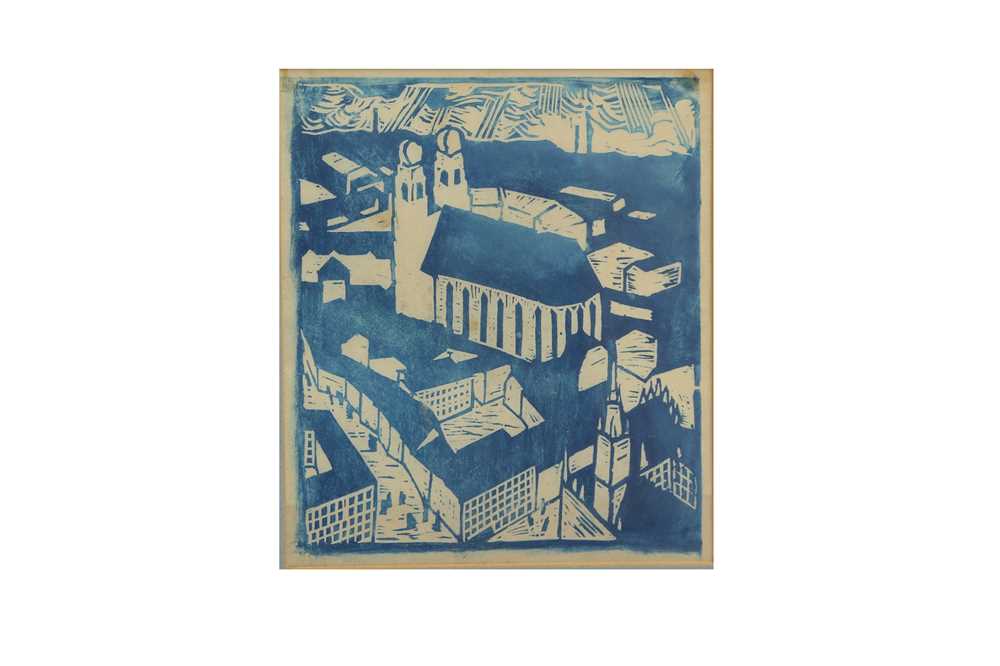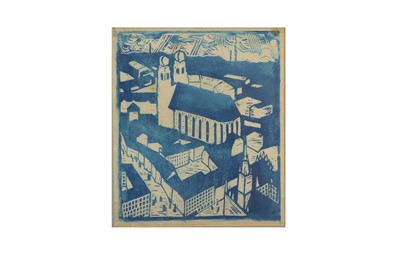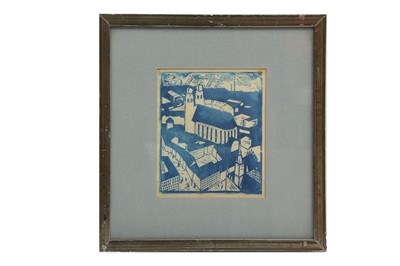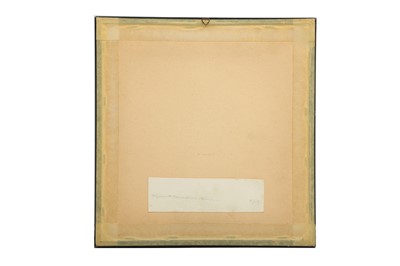30th Mar, 2021 14:00
19th & 20th Century Paintings and Works on Paper, including Portrait Miniatures
LOUIS CHRISTIAN HESS (AUSTRIAN 1895-1944)
Property from the Estate of Louis Christian Hess
LOUIS CHRISTIAN HESS (AUSTRIAN 1895-1944)
Frauenkirche
linocut
16 x 14.6 cm (6 3/4 x 5 3/4 in)
Executed in Munich in 1919 during the early years of the Weimar Republic when Hess was studying at the Academy of Fine Arts. The work reflects Hess's clear interest in the woodcuts of the German Expressionists, in particular those of Karl Schmidt-Rottluff, who worked almost exclusively in this medium after the First World War. It shares particularly striking similarities with Schmidt-Rottluff’s woodcut Stadtbild aus Soest of 1923, in the collection of The Cleveland Museum of Art. In both the church spires extend to the sky, whilst the jagged angles and patterns of light express a vivid energy.
Seven Works from the Estate of Louis Christian Hess (lots 321 - 327)
Louis Christian Hess (1895-1944) was strongly influenced by German Expressionism and the Neue Sachlichkeit. He became friends with Max Beckmann and Karl Hofer and was a leading voice in the Juryfreie in Munich. Very few of his works have ever appeared on the market, and this marks the first time a group has been offered at auction.
Hess was born in Bolzano in the South Tyrol; his father was an office clerk, his mother from the Austrian bourgeoisie. In 1906 the family moved to Innsbruck where Hess studied at the Staatsgewerbeschule (State Institute of Art), and in 1915 he had his first exhibition of drawings and prints at the Thurn und Taxishof Galerie.
His formative years, however, were overshadowed by a succession of family bereavements and the horrors of the First World War. Between the ages of 10 and 22, he lost his father and two of his three sisters to tuberculosis, and learnt of the death of his mother whilst on the German front line, where he fought in the battles of Verdun, the Somme and Aisne. By the end of the War he had one remaining sibling, his sister Emma, to whom he remained close. But his war time experiences combined with unfolding family tragedies scarred him psychologically, and left him with a nervous disposition for the rest of his life.
In 1919, during the early years of the Weimar Republic, Hess began studying at the Academy of Fine Arts in Munich under Carl Johann Becker-Gundahl. Although the Academy was conservative in outlook, it was there that Hess developed his natural skill as a colourist. In 1920 he exhibited in the Ausstellung Junger Münchner – Graphische Kunstwerkastätten, where his work was singled out by the critic George Jacob Wolf for having ‘an uncommonly developed sense of colour’.
Munich in the 1920s was home to the artists most closely associated with Neue Sachlichkeit (The New Objectivity) – amongst them Otto Dix, George Scholz, Christian Schad and Max Beckmann. Although Hess was not formally associated with the movement, he became friends with Beckmann in the late 1920s, and the influence of the style can clearly be seen in his work.
In 1925 Hess travelled to Sicily to visit his sister Emma in Messina. He wrote to his friends in Germany that he had found paradise, and so inspired, in 1926 he produced a series of 60 vibrant Sicilian etchings, and returned repeatedly to the island thereafter.
Hess joined the progressive Juryfreie in Munich in 1929, becoming one of the group’s leaders. The Juryfreie (Jury-free) was self-adjudicating and open to artists from all traditions. During the 1920s and early 1930s it was the most liberal exhibiting body in Munich; some members included Wassily Kandinsky and Oskar Schlemmer. In July the same year Art critic Wilhelm Hausenstein wrote in Aus meinem Künstnotizbuch that the ‘Juryfreie reveals itself as a prominent artistic group... I notice Christian Hess, Josef Scharl, Fritz Burkhardt, Grassmann, Panizza and sculptors such as Spengler and Zeh’.
With wider recognition for his work Hess also exhibited with the Secessionists at the Glaspalast in the early 1930s. But disaster and disruption followed. Tragically several of his works were destroyed in a catastrophic fire at the Glaspalast in June 1931. Devastated, Hess wrote on a postcard to his sister Emma illustrating the ruins of the Glaspalast fire: ‘here lie my works: all burnt’. The same year too, following public demonstrations by the Juryfreie, Hess and others were banned from the group by the far-right paramilitary wing the SA, and in 1934, with Hitler’s rise to power, the Juryfreie was disbanded as they were viewed as ‘culturally bolshevic’.
Following the financial crash of 1929, the on-set of the Depression and widespread unemployment, Hess wrote to Emma in 1932: ‘Financially, circumstances have never been so catastrophic. Wherever you are and whoever you speak to, everyone grumbles…and politics are the main theme.’ The following year, with mounting political instability, and with his art viewed as degenerate by the authorities, Hess fled Germany to join his sister in Sicily with his wife, the actress Cecilia Faesy.
But Hess's years with Cecilia were short lived; in 1936 she left him to travel to Switzerland. The rupture caused the artist extreme mental instability and pushed him to attempted suicide. He lived for a further two years in Sicily before returning to Munich in 1938, leaving many of his paintings behind him in the care of his sister. Forced to conscript in 1940, due to his fragile health Hess was assigned work at the post office, but in December of 1940 he fell seriously ill and was discharged. He returned to Austria and in 1944 died in hospital at the age of 48 after an air raid over Innsbruck.
During the Second World War Messina suffered extensive bombing due to its strategic position. To protect the paintings her brother left behind, Emma rolled and wrapped them, shielding them in air-raid shelters. After Hess’s death Emma oversaw his estate and the survival of a significant numbers of his work. The seven lots in this sale are from the group that Hess delivered to his sister when he revisited Messina in 1936.
Sold for £450
Includes Buyer's Premium
Do you have an item similar to the item above? If so please click the link below to request a free online valuation through our website.



